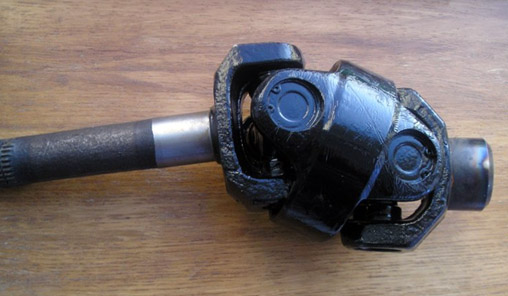 CROSS JOINTS – It is the simplest form of a joint, torque transmission during rotation of significantly deflected shaft sections. The construction of the universal joint is simple: it consists of two hinges with rotation axes perpendicular to each other. Practical design solutions may vary, but most often such a joint includes a central part
CROSS JOINTS – It is the simplest form of a joint, torque transmission during rotation of significantly deflected shaft sections. The construction of the universal joint is simple: it consists of two hinges with rotation axes perpendicular to each other. Practical design solutions may vary, but most often such a joint includes a central part
in the form of a cross, forming perpendicular axes of rotation. Both ends of the shafts connected by a joint are mounted on the cross pins by needle bearings. Joints of this type come in a wide variety of sizes, from small in diameter 1+2 cm, used in auxiliary equipment, after very large, used in trucks and heavy equipment. Permissible angle of deflection of shafts, connected by a universal joint, depends on the size and structure of such a joint and the rotational speed of the shaft. This speed can reach several thousand rpm, and the permissible angle of deflection of the shaft ranges from a few degrees (for the highest turnover) to over 30 degrees for low-speed shafts.
However, be aware of this, that a single universal joint is not a constant velocity joint (simultaneous), that is, it does not provide a constant ratio of the speed of the output shaft to the input shaft. In design practice, a system of two shafts connected by a single universal joint is not used, because at each non-zero deviation of the shafts, their rotation would be accompanied by vibrations and cyclic fluctuations of forces occurring in this assembly. However, there is an easy way to get around this limitation: use of two universal joints in one shaft, in which in the middle section of the shaft the forks coupled to it are in one plane. This design creates a homokinetic shaft called a cardan shaft or simply a cardan constant velocity joint, when the middle section of the shaft is close to zero in length. Moreover, if the total length of the shaft is significant, construction requires, so that its central part is supported by a flexible bearing. Such an arrangement is commonly used in car shafts, in which torque is transferred from the front-mounted thrust unit to the rigid rear axle. We then have a team: flexible joint, support bearing, a sliding element that allows the shaft length to be changed and a short classic cardan shaft with two universal joints. Let us note, that while driving, the assumptions of equal shaft deflection angles and mounting the entire unit in one plane may not be met, therefore, the role of the flexible joint to mitigate vibrations is very important. Cardan shafts are rarely used as short driveshafts in independent suspensions, and the reason is the very large variability of the relative position of the input and output shafts occurring in such a solution. For the same reason, they are not suitable for transmitting drive torque on steered axles. However, in the drive shafts, they are characterized by high durability, as long as the pivot bearing of the cross members are properly lubricated and protected against dirt.